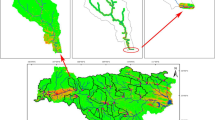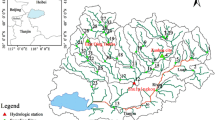Abstract
Watershed-wide land-cover proportions can be used to predict the in-stream non–point source pollutant loadings through regression modeling. However, the model performance can vary greatly across different study sites and among various watersheds. Existing literature has shown that this type of regression modeling tends to perform better for large watersheds than for small ones, and that such a performance variation has been largely linked with different interwatershed landscape heterogeneity levels. The purpose of this study is to further examine the previously mentioned empirical observation based on a set of watersheds in the northern part of Georgia (USA) to explore the underlying causes of the variation in model performance. Through the combined use of the neutral landscape modeling approach and a spatially explicit nutrient loading model, we tested whether the regression model performance variation over the watershed groups ranging in size is due to the different watershed landscape heterogeneity levels. We adopted three neutral landscape modeling criteria that were tied with different similarity levels in watershed landscape properties and used the nutrient loading model to estimate the nitrogen loads for these neutral watersheds. Then we compared the regression model performance for the real and neutral landscape scenarios, respectively. We found that watershed size can affect the regression model performance both directly and indirectly. Along with the indirect effect through interwatershed heterogeneity, watershed size can directly affect the model performance over the watersheds varying in size. We also found that the regression model performance can be more significantly affected by other physiographic properties shaping nitrogen delivery effectiveness than the watershed land-cover heterogeneity. This study contrasts with many existing studies because it goes beyond hypothesis formulation based on empirical observations and into hypothesis testing to explore the fundamental mechanism.




Similar content being viewed by others
References
Allan JD, Erickson DL, Fay J (1997) The influence of catchment land use on stream integrity across multiple spatial scales. Freshwater Biology 37:149–161
Arnold CA (2006) Clean-water land use: connecting scale and function. Pace Environmental Law Review 23:291–350
Beaulac MN, Reckhow KH (1982) An examination of land use-nutrient export relationships. Water Resources Bulletin 18:1013–1024
Bray JR, Curtis JT (1957) An ordination of the upland forest communities of southern Wisconsin. Ecological Monographs 27:325–349
Broussard W, Turner RE (2009) A century of changing land-use and water-quality relationships in the continental US. Frontiers in Ecology and the Environment 7:302–307
Buck O, Niyogi DK, Townsend CR (2004) Scale-dependence of land use effects on water quality of streams in agricultural catchments. Environmental Pollution 130:287–299
Caraco NF, Cole JJ, Likens GE, Lovett GM, Weathers KC (2003) Variation in NO3 export from flowing waters of vastly different sizes: does one model fit all? Ecosystems 6:344–352
Ekholm P, Kallio K, Salo S, Pietiläinen OP, Rekolainen S, Laine Y, Joukola M (2000) Relationship between catchment characteristics and nutrient concentrations in an agricultural river system. Water Research 34:3709–3716
Field JG, McFarlane G (1968) Numerical methods in marine ecology. 1: A quantitative similarity analysis of rocky shores samples in False Bay. South Africa. Zoologica Africana 3:119–137
Fulmer WR, Fowler C (2007) Implementing agricultural components of the Upper Coosawattee TMDL implementation plans through best management practice installation. In: Proceedings of the 2007 Georgia Water Resources Conference, University of Georgia, Athens, GA
Gardner RH, Urban DL (2007) Neutral models for testing landscape hypotheses. Landscape Ecology 22:15–29
Gergel SE (2002) Assessing cumulative impacts of levees and dams on floodplain ponds: a neutral-terrain model approach. Ecological Applications 12:1740–1754
Gergel SE (2005) Spatial and non-spatial factors: when do they affect landscape indicators of watershed loading? Landscape Ecology 20:177–189
Hunsaker CT, Levine DA (1995) Hierarchical approaches to the study of water quality in rivers. Bioscience 45:193–203
Johnson GD, Myers WL, Patil GP (2001) Predictability of surface water pollution loading in Pennsylvania using watershed-based landscape measurements. Journal of the American Water Resources Association 37:821–835
Jones KB, Neale AC, Nash MS, Van Remortel RD, Wickham JD, Riitters KH et al (2001) Predicting nutrient and sediment loadings to streams from landscape metrics: a multiple watershed study from the United States Mid-Atlantic region. Landscape Ecology 16:301–312
Keitt TH (2000) Spectral representation of neutral landscapes. Landscape Ecology 15:479–493
King RS, Baker ME, Whigham DF, Weller DE, Jordan TE, Kazyak PF et al (2005) Spatial considerations for linking watershed land cover to ecological indicators in streams. Ecological Environmental Management Applications 15:137–153
Lancaster J (2006) Using neutral landscapes to identify patterns of aggregation across resource points. Ecography 29:385–395
Li H, Reynolds JF (1994) A simulation experiment to quantify spatial heterogeneity in categorical maps. Ecology 75:2446–2455
Li H, Reynolds JF (1995) On definition and quantification of heterogeneity. Oikos 73:280–284
Lin Z, Radcliffe DE, Rissec LM, Romeisd JJ, Jackson CR (2009) Modeling phosphorus in the Lake Allatoona Watershed using SWAT: II. Effect of land use change. Journal of Environmental Quality 38:121–129
National Research Council (1999) New strategies for America’s watersheds. National Academy Press, Washington, DC
Pearson SM, Gardner RH (1997) Neutral models: useful tools for understanding landscape patterns. In: Bissonette JA (ed) Wildlife and landscape ecology: effects of pattern and scale. Springer, New York, pp 215–230
Peterson EE, Sheldon F, Darnell R, Bunn S, Harch B (2011) A comparison of spatially explicit landscape representation methods and their relationship to stream condition. Freshwater Biology 56:590–610
Robinson WS (1957) The statistical measurement of agreement. American Sociological Review 22:17–25
Robinson WS (1959) The geometric interpretation of agreement. American Sociological Review 24:338–345
Roth NE, Allan JD, Erickson DL (1996) Landscape influences on stream biotic integrity assessed at multiple spatial scales. Landscape Ecology 11:141–156
Schoonover JE, Lockaby BG, Pan S (2005) Changes in chemical and physical properties of stream water across an urban-rural gradient in western Georgia. Urban Ecosystems 8:107–124
Smith SV, Swaney DP, Buddemeier R, Scarsbrook MR, Weatherhead MA, Humborg C et al (2005) River nutrient loads and catchment size. Biogeochemistry 75:83–107
Strayer DL, Beighley RE, Thompson LC, Brooks S, Nilsson C, Pinay G et al (2003) Effects of land cover on stream ecosystems: roles of empirical models and scaling issues. Ecosystems 6:407–423
Van Sickle J (2003) Analyzing correlations between stream and watershed attributes. Journal of the American Water Resources Association 39:717–726
With KA, King AW (1997) The use and misuse of neutral landscape models in ecology. Oikos 79:219–229
Yang X (2012) An assessment of landscape characteristics affecting estuarine nitrogen loading in an urban watershed. Journal of Environmental Management 94:50–60
Young WJ, Marston FM, Davis JR (1996) Nutrient exports and land use in Australian catchments. Journal of Environmental Management 47:165–183
Zhang T (2010) A spatially explicit model for estimating annual average loads of nonpoint source nutrient at the watershed scale. Environmental Modeling & Assessment 15:569–581
Zhang T (2011) Distance-decay patterns of nutrient loading at watershed scale: regression modeling with a special spatial aggregation strategy. Journal of Hydrology 402:239–249
Acknowledgments
We thank for the Department of Geography at Florida State University and the Department of Fisheries and Wildlife at Michigan State University for time release in conducting this research. The research reported in this study was partially supported by Florida State University Council on Research and Creativity and United States Environmental Protection Agency’s Science to Achieve Results Estuarine and Great Lakes program through funding to the CEER-GOM, USEPA Agreement No. R829458. Acknowledgments are due to Morton Winsberg for help in reviewing the early version of the manuscript and to the anonymous reviewers for their constructive comments that helped improve the scholarly quality of our manuscript.
Author information
Authors and Affiliations
Corresponding author
Rights and permissions
About this article
Cite this article
Zhang, T., Yang, X. Predicting Nitrogen Loading With Land-Cover Composition: How Can Watershed Size Affect Model Performance?. Environmental Management 51, 96–107 (2013). https://doi.org/10.1007/s00267-012-9897-3
Received:
Accepted:
Published:
Issue Date:
DOI: https://doi.org/10.1007/s00267-012-9897-3




